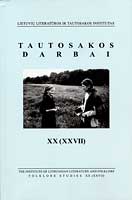лингвистические и художественные особенности комментариев
Artistic and linguistic pecularities of commentaries
Author(s): Jevgenija NikolajenkoSubject(s): Customs / Folklore
Published by: Lietuvių literatūros ir tautosakos institutas
Keywords: Commentaries; paremy; artistic pecularities; linguistic pecularities; foreign expression; dialect
Summary/Abstract: The article deals with two problematic aspects: 1) certain artistic and structural character of commentaries, 2) linguistic and cultural peculiarities of Jelizaveta Kolesnikova’s speech. J. Kolesnikova was born 1917 in Salakas (district of Zarasai in Eastern Lithuania), into a Russian family of old-believers. She is a prominent folklore collector and performer, and her commentaries to the folklore texts are surprisingly well structured and insightful. Commentaries analyzed here serve in quite a number of ways, including explanations of lexical forms, dialectal or foreign expressions; there are commentaries-translations, commentaries-variations, commentaries supplying additional information, and commentaries-hints. Semantic explanations of the entire phrase can be given in one word, lexical combination or sentence, and text. As often as not the context significantly exceeds the proverb itself, developing into a separate narrative (e.g. anecdote or tale), directly related to the proverb in question or just loosely associated with it. The contextual information can include both facts of the personal life and abstract things. Linguistically the commentaries could be described as multilingual stylistically diversed texts. Uniquely preserved elements of the Pskov dialect, blended into the “local” dialect on the grounds of the spoken language deserve separate attention. These peculiarities can be noticed at all the speech layers.
Journal: Tautosakos darbai
- Issue Year: 2004
- Issue No: 27
- Page Range: 134-139
- Page Count: 6
- Language: Russian

